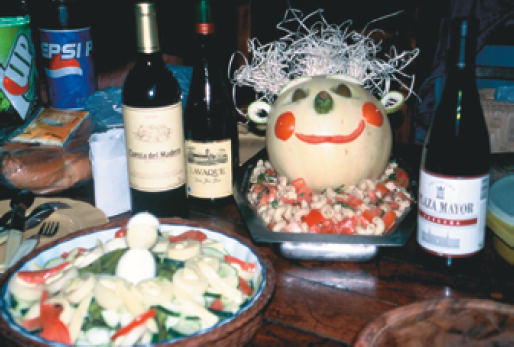Secrets of a cheese lover revealed at last
Whether you decide on cocktail nibbles, late-night snacks, a sandwich filler, or a main course spice, cheese is one of the most versatile ingredients in a cruiser’s galley. The addition of tasty chunks of spiced feta can change a boring salad into a gourmet treat. A hefty spread of toasty melted mature cheddar on top of simple onion soup can turn the grayest passage day five shades brighter. But buying, preparing, and keeping a variety of cheeses afloat and edible for long periods take planning.
If you enjoy the flavor and texture of long-life processed cheese products, such as Kraft cheddar, you’ll have little problem finding them worldwide. I was surprised to see three brands of boxed, processed cheese in the most isolated African villages, clad in the same packaging I’d seen in Aden and the Tuamotus. These processed cheeses last up to two years with no refrigeration as long as they’re kept in their sealed containers. I’ve cut them into half-inch cubes and skewered them with pickled onions or green olives for a cocktail snack at a cruisers’ picnic. Not wondrous . . . but definitely edible. Grated, processed cheese adds variety to salads. But this manufactured milk product is no substitute for unprocessed cheese in cooking because it does not melt or brown and can cause some cheese-dependent recipes to fail.
Grated Parmesan cheese also keeps well afloat with no care other than protection from moisture. I find it is best to avoid cardboard tubes of Parmesan because the humidity afloat will cause the cardboard to soften and the cheese to mildew. I buy sealed plastic pouches instead.
If you have been at sea long enough to use up your fresh cheese, a good quick-browning cheese topping for casseroles can be made by mixing half mayonnaise (regular or light style) with half grated Parmesan cheese, plus a few drops of vinegar, and then grilling or baking. This same mix works for cocktail treats. Put a dill pickle slice on a small round of toast, top it with a mound of Parmesan-mayo mix, and grill until browned.
The cheeses we depended on during passages on 24-foot Seraffyn were canned Brie and Camembert. We try to buy the Danish brands that are not stored in the refrigeration section of the market. If we could find only cans (usually packed inside small, flat, square cardboard boxes) marked “keep refrigerated” or “keep cool,” I still bought a dozen for each passage. In our experience these will last up to six months if stored low in the boat where the temperatures are the same as the outside water temperature. In tropical waters I would only count on two months.
These cheeses definitely age in their cans. Most of them are marked with a “use by” date. I look for cheeses nearing expiration because I have found that we like the texture and flavor of longer-aged Brie and Camembert.

Preservation ideas
To enjoy a wider variety of cheese – such as cheddar, Edam, or feta – here are several preservation ideas. If you have a freezer, try sealing cheddar cheese in plastic containers and storing them in the upper area of the chest. The cheese will be more crumbly when it’s defrosted, so it is wise to select younger cheddars for preservation by freezing. If the cheese is well sealed, the flavor will change very little. Water-packed cheese, such as feta, will freeze well as long as there is some space inside the container to allow for expansion of the liquid. However, I’ve never been satisfied with the flavor or texture of Edam or Colby cheese kept this way.
Simple refrigeration or icebox storage in sealed containers works well for cruises that last less than three weeks (the majority of passages we make fall within this time limit). If you can get small waxed cheeses and store them so the wax stays intact, they will keep perfectly for up to two months at temperatures below 55º F.
The vinegar caper
Unwaxed cheese should be wiped lightly with vinegar and then wrapped in plastic wrap and stored where it will not be bumped around too much. If any mold forms, it should be cut off and the cheese wiped with vinegar again. If you prefer using plastic cheese boxes rather than wrapping each cheese separately, wipe the inside of the box with vinegar once a week to discourage mold formation. Since mold does not penetrate more than a fraction of an inch below the surface of a hard cheese, it’s most economical to buy one large chunk rather than several smaller ones. Once a week or so, cut off the cheese you plan to use for the next meals, remove any mold from the main supply, and wipe it down with vinegar. By doing this simple step, your loss due to mold will be reduced by up to 50 percent. When I have room in my ice chest for 2-kilo blocks of cheddar such as sold by many ship chandlers, I find that I lose about 8 to 10 percent of the cheese to mold during a month’s cruise.
Cheese submerged in olive oil
Water-packed feta will last for two months under refrigeration or on ice. But when we were provisioning Taleisin in Fremantle, Australia, the proprietor of the Mouse Trap Cheese Shop taught me an even better way to preserve and improve the flavor of feta with no refrigeration at all. Simply submerge the feta in pure olive oil in a sealed container. (I use the oil straight from its container; I do not preheat it in any way.) Our feta stored in olive oil in a clean glass pickle jar lasted for more than a year in the bilge during a cruise through the Indian Ocean. There was no change in flavor.
The same cheese specialist taught me a wonderful way to create what can only be called “gourmet feta.” I clean a 1-gallon pickle jar and fill it loosely with 2-inch cubes of feta. I then pour 3 tablespoons of green peppercorns on top of the feta and shove about 10 inches of fresh rosemary into the jar before I fill it to within an inch of the top with fresh olive oil. If you do not like things that are hot to the tongue, you can use as a substitute 1 tablespoon of black peppercorns plus several bay leaves or green and red sweet pepper flakes.
After three months, the feta jar will be at its prime. You can add fresh feta to the oil at any time. Be sure to dry the cheese well by letting the water it was packed in by the manufacturer drain off for at least 10 minutes. Then pat it dry and shove it into your oil-based mixture. I like to wait until I have used enough of the original cheese so I can place the fresh supply below the more-spiced cubes without making a mess with the olive oil.
To serve this oiled feta in salads, I use it as it comes from the jar and even use some of the spiced oil as a dressing. For hors d’oeuvres I drain the feta on a paper towel before slicing it onto biscuits or toast. The texture of the cheese becomes creamier as it ages. After six months I find the feta packed in green or black pepper becomes a bit stronger than I like, so I transfer any that is left to plain olive oil. The plain oil can be reused for up to three years. The spiced oil can be used two or three times, but after 18 months I have found that mine becomes cloudy and less-appetizing, so I discard it and start again with fresh oil.
Hard cheddar cheese can also be kept this way. I put up 5 kilos into plain olive oil before we left Fremantle, and it didn’t change flavor or texture for three months. After that I detected a slight flavor change, which was noticeable if we used the cheddar as it came from the jar. But mixed with other ingredients and cooked in any way, the cheese tasted just fine.
Olive oil will leak out of everything! So I store my big cheese jars inside a bucket in the bilge. I line the bucket with old newspapers to soak up any leakage. A bit of trouble, yes, but what a treat that spiced cheese is when all your other fresh food is a memory.
Dorothy Skeates, who cruised extensively for several years on Wylo II (a boat with Spartan accommodations) before working as charter cook along the Great Barrier Reef, still waxes her own cheeses. Dorothy chooses firm cheese and cuts it up to the size she’ll use in one week. She then wipes each chunk with vinegar and wraps it in three layers of muslin that’s been soaked in a solution of half boiled water and half boiled vinegar and sun-dried. Dorothy then paints each cheese with melted candle wax (called paraffin wax in the U.S.). She coats each cheese three times to be sure it’s perfectly sealed. The cheeses are then stored below the waterline, well wrapped in newspaper to prevent the wax from breaking. This method is more labor-intensive than the others I’ve listed, but the waxed cheese takes less space than jars filled with oil, so waxing is a good choice for non-spiced cheese on smaller cruising boats. The cheese will last up to six months with this system.
Ye Olde England
The final cheese preservation method that I have learned in our years of exploring is a famous British Yule-tide treat — expensive, but wonderful anytime, anywhere. Purchase a 7-pound whole, relatively young, round of Stilton or blue cheese. Find an air-tight crockery or glass container to fit closely around the cheese (within ½ inch on all sides). Scoop a hole approximately half the size of a teacup into the top center of the cheese. (Eat this center scoop with fresh grapes or a slice of apple.) Pour fine port wine of your preference into the depression. Set the cheese in a locker low in the boat where it will keep relatively cool and the motion will not be too violent, so the wine can seep slowly through the holes and permeate the cheese. Top up with port once a week. Taste the cheese two or three months later. If it withstands your sampling, it will last for up to a year.
In England this is called “drunken Stilton,” traditionally eaten by spooning it on top of crispy toast as you sip your after-dinner wine in front of a holly-bedecked fireplace. But it is equally good as a reminder of your friends and family up north when you are finishing a meal of fresh lobster and enjoying a dessert of fine sweet pineapple to celebrate Christmas — or any special occasion — at anchor beside a coral atoll.
This article was excerpted from the Pardeys’ book, The Care and Feeding of Sailing Crew, which has just been updated and released as a third edition.






